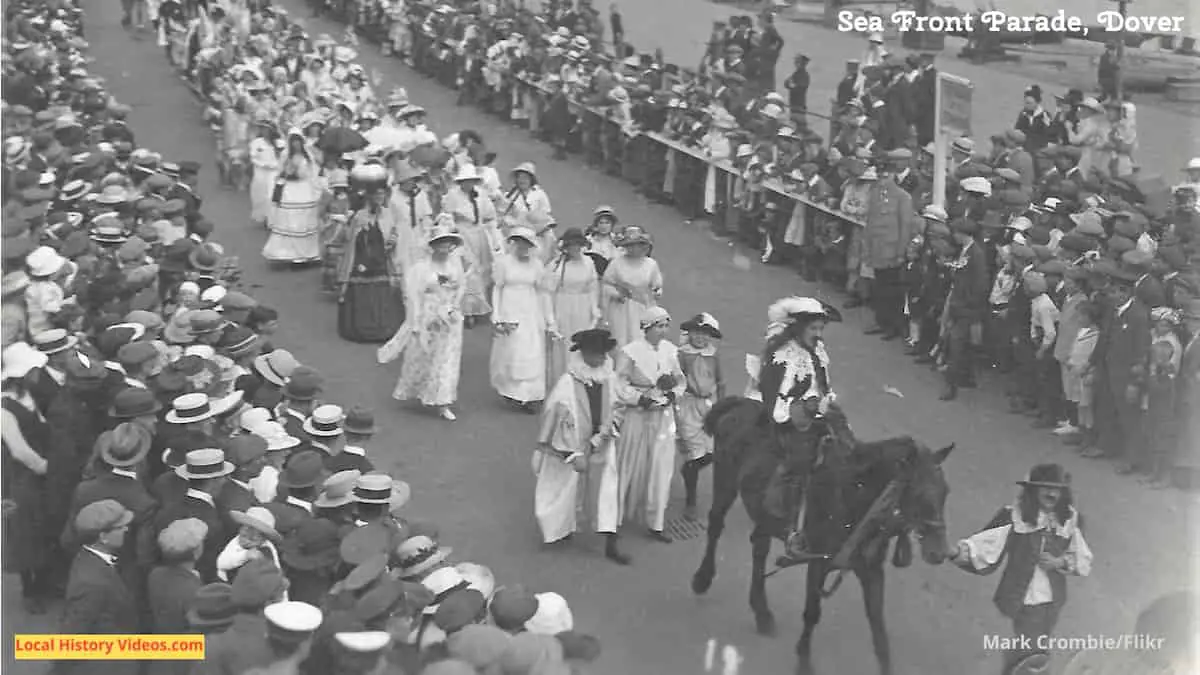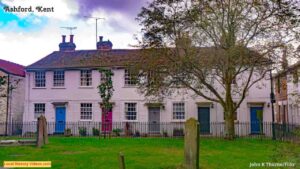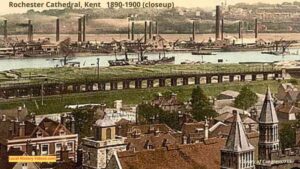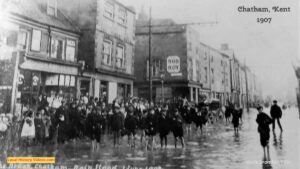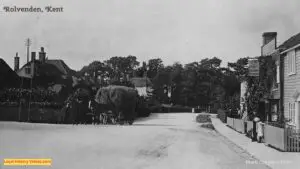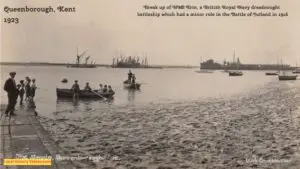Glimpse history through old images of Dover, Kent, on England’s south coast.
Bomb Damage 1940
A newsreel from 29 August 1940 captures the damage done to residential streets and homes across Dover and Ramsgate by the German Lufftewaffe’s incendiary devices and bombs.
Ramsgate and Dover Damage And Air Duel (SE Coast Towns Give and Take) – British Movietone on YouTube
The bombers returned to wreak more havoc as the next newsreel shows, dated 23rd September 1940.
Dover Bombed Again – British Movietone on YouTube
Dover’s War
The short film made in 1944 shows some of Dover’s wartime experiences as recorded by Pathe Gazette cameraman Pat Gay. Four years of bombardment had caused significant damage to the town and its inhabitants.
Scenes shown include the railway station, Churchill Street, Anderson shelters and wounded people being taken to hospital.
Hellfire Corner Aka Hell Fire Corner (1944) – British Movietone on YouTube
Carnival 1959
The local newsreel of Dover’s Carnival in 1959 records not only the procession and the crowds of people who turned out to see it, but also some of the businesses and buildings in the background.
Dover Holds Carnival – Special (1959) – British Pathé on YouTube
Historic Book
Extract from “The history of the town and port of Dover and of Dover castle” Volume 1, by John Lyon
Published in 1813
Pages 140 – 145
The first alms – house at Dover , was situated in the ward of Saint Nicholas , and adjoining to the church of the same name; and , according to tradition , it was given by some charitable person , prior to there being any assessment for the relief of the poor , for the reception of such persons as might be destitute of a lodging .
As early as the year 1592 , the mayor , jurats , and commonalty of the town of Dover , agreed with Oliver Lygo , to exchange the alms house in Bench – street , for a house in Saint George’s ward .
These premises were either very much out of repair , or they were suffered to go to decay ; for Robert Justice , in his will , proved in the year 1552 , gave to those who would undertake to re – build this house , six shillings and eight – pence , towards the expence . As this work was not undertaken until the year 1611 , it is very probable the legacy was lost .
This house had the appearance of an hospital , within the memory of many living ; for there were a row of beds fitted up on the side of a large room , ready to receive the distressed petitioners ; but the house is now converted into a private dwelling , and the beds are partitioned off in the large room .
The mayor , for the time being , is called the master of the alms house , and two of the common council are wardens and treasurers. These officers have the management during the year .
The early accounts of this charity are not in being ; and it is , therefore , difficult to ascertain for what particular charitable purposes it was intended . As the foundation dates its origin prior to any assessment being made for the relief of the poor , it might possibly , at that time , have been intended for the general relief of paupers ; but the present received opinion is , that it was founded for the purpose of administering temporary aid to distressed soldiers and sailors , and
their wives , in passing through this town .
In consequence of the intentions of the charitable donor not
being particularly understood , some unpleasant disputes have heretofore arisen , between the governors of this charity , and the visitor and guardians of the poor of the parish of Saint Mary the Virgin , respecting what kind of persons were the proper objects of it ; the latter conceiving , that they were frequently burdened with much casual poor , which ought to have been provided for by the fund arising from this charity .
At the time an inquiry was made into the distribution of the
different charities , it was ordered in vestry , that the visitor and guardians of the poor , should apply to the mayor and his brethren , for permission to inspect the accounts of the application of the receipts belonging to the alms – house ; but the order , for various reasons , was not put in execution until the year 1802 , when the following petition was addressed to the governors .
“To the worshipful the mayor of the town and port of Dover , master of the alms – house ; to the jurats , the wardens of the same ; to the chamberlain and treasurer ; and to the other jurats , and the common council , of the said town
and port .
The humble petition of the visitor and guardians of the poor , of the parish of Saint Mary the Virgin , in the town of Dover . 42;
” Sheweth , That your petitioners , in consequence of the many disputes which , from time to time , have arisen , between the magistrates of this town and your petitioners , relative to the providing for distressed soldiers and sailors , and their
wives , who , in passing through this : town , have applied for relief , and the parish of Saint Mary has frequently been burdened with expences , which your petitioners humby conceive , ought to have been provided for by the governors
and the directors of the alms – house , out of the fund , arising from the reats of the lands and tenements belonging to the said charity ; the parishioners of the parish of Saint Mary , being desirous of preventing such disputes in future ,
have judged it necessary to direct your petitioners , in and by an order of vestry , dated the 17th day of August , 1800 , to petition the governors of the said charity , for permission to inspect the book , or books , which contain the accounts of
the receipts and disbursements of the sums by them , from time to time , received , laid out , and expended ; and the parishioners finding that their said order hath not been put in execution , they again , in and by an order of vestry , dated the
8th day of April last passed , directed your petitioners to apply for the aforesaid information . We do therefore , in pursuance of our instructions , in behalf of the inhabitants of the parish of Saint Mary , humbly request permission , to inspect the said book , or books , at such time and place , as you may be pleased to judge most convenient to yourselves , or to any person whom you may be , pleased to appoint to exhibit the said accounts , to enable your petitioners to make a report to the inhabitants of the said parish , agreeably to their instruc
tions ; or inattention to their order may be imputed to your petitioners , which they wish to avoid . “
This petition was not noticed by the governors during several
months , in consequence of a common assembly not having been held from June , 1802 , until January , 1803 ; and the visitor and guardians of the poor , being at that time ignorant of the cause of their silence , renewed their application , under another order of vestry , for inspecting the accounts . The governors for some time resisted this application , under an opinion , that it had not been made to them in so respectful a manner as their situation warranted them to expect ; but ,
after much altercation , an order was made by the common assembly to grant the subject of the petition . This brought the matter to a conclusion .
The accounts were inspected , and the ancient and present state of the income of the different charities , and the other particulars which were the objects of the inquiry , were clearly ascertained .
The earliest records of the receipts and disbursements of this charitable institution , begin in the year 1629 ; and there is a long chasm of one hundred and seven years , from the appropriation of the alms house for the reception of distressed persons , to the beginning of the existing accounts .
Whether the first records of this charity have perished by time or by any other means , their loss must have frustrated every endeavour to gain information , relative to the ancient distribution ; if the existing accounts had not contained sufficient internal evidence to establish the original designs of the pious donors.
In a terrier of the lands , taken in 1629 , when Luke Pepper was mayor , and master of the alms – house , and Valentine Tatnell , and William Richards , wardens , there is mention made of the occupiers of the lands at that time , the parishes in which they are situated , the number of acres , and the rents paid .
Thomas Broom , by an indenture of lease , held twelve acres of arable land belonging to the alms – house , in the parish of Hougham , at the yearly rent of twelve pounds .
John Westhrope had the assignment of a lease of a piece of land , near Cow-gate , containing , by estimation , half an acre , at the yearly rent of thirty shillings , purchased of Mr. Midge , and devised to George Bing , jurat . On one part of this land , certain messuages or cottages were built .
John White paid an annuity of twenty shillings , for a messuage , garden , and orchard , situated in Biggin Street , and by him purchased of Alexander and William Deeds ; formerly the property of Thomas Andrews , gentleman , and by him given to the alms – house .
Thomas Brounger , senior , and the assigns to Thomas Brounger , deceased , held by lease two tenements , belonging to the alms – house , at the yearly rent of twelve – pence .
Margaret Marsh , widow , was a tenant at will , of one piece or
parcel of ground , heretofore belonging to Mr. Child , lying near to Mr. James Huggesson’s garden pales , wall , and meadow , in the parish of Saint James , at the yearly rent of twenty shillings .
John Randal held a piece of meadow land , at Paul’s Corner , at the yearly rent of five pounds ten shillings .
By a memorandum in the accounts , dated in the year 1572 , it appears , that Mr. Stokes paid into the hands of the master of the alms house , twenty pounds ; but the money was not to be incorporated with the fund of the charity ; but the principal , and the interest were to be reserved , for the relief of such persons as might , in any future time , be visited with the plague .
This sum was given by different persons in the town , and it was laid out in the purchasing of land at Tilmanstone ; which is now included in the lands belonging to the alms – house .
Thomas Brice , in the year 1677 , left to the master and wardens , a piece of land , which rented at twelve shillings by the year , for the relief of those who might be afflicted with the plague . If this charity was
ever united with the preceding ones , it has escaped notice .
The only mention we saw of this gift , was in the accounts , where it appeared , that in the same year of the donation , there was a charge of twenty shillings , for making a conveyance , from him to the master and wardens , which is clear proof that the land was given , but why
his name did not appear in the terrier is now unknown .
In the year 1685 , there were two cottages , near Cow-gate , which had been suffered to go to decay , and the materials were sold .
Mr. Buck , mayor , and the wardens of the alms – house , in 1699 , sold the lands to Monins and Kennett , for three pounds. These werethe tenements held by Brounger .
In the year 1607 , the corporation borrowed of the alms – house fund fifty pounds , and mortgaged the town – house for the security of the money . They paid interest at the rate of five pounds for an hundred ; and , in 1755 , it was reduced to four pounds .
In the year 1758 , they borrowed one hundred pounds more ; and they still appear to be indebted to the charity for the above sums , and for which they have regularly charged themselves with the interest in
passing the accounts ….
Page 146
…It further appears , that for the first fifty years , from the year
1629 , the objects which had been relieved were of every description .
They were not only soldiers and sailors , and their wives , but foreigners of various nations ; persons who had been taken prisoners , sick men and women , and their children ; cripples ; boys , with their hands perished with the frost ; melancholy persons , and persons with the small pox ; and when it was judged imprudent to take them into the house , they were provided for as out pensioners .
If they died , they were buried at the expence of the fund ; and those who were fit to proceed on their journey , and did not like to quit the town , were sent as far as Buckland .
These early accounts seem to point out the objects for whom these charities were intended , and to whom they were given for many years ; and they also shew , what kind of persons ought now to obtain relief from the fund .
When houses of this description were first adopted for the reception of distressed objects , parochial assessments for their relief were unknown ; and , after the suppression of the religious houses , without some asylum for the reception of paupers , they must have perished , when sick and infirm , and exposed to the inclemency of the seasons .
It is certainly very probable , that these charitable donations were originally applied to assist parochial , as well as other poor , when the fund would admit of it , and that the funding system was not introduced , until after rates for the relief of the poor were established by law .
When statutes were passed , to prevent paupers from leaving
their parishes , soldiers , sailors , and persons who had been taken prisoners , were the only poor who wandered about the country , and they were sent by passes to their different homes .

